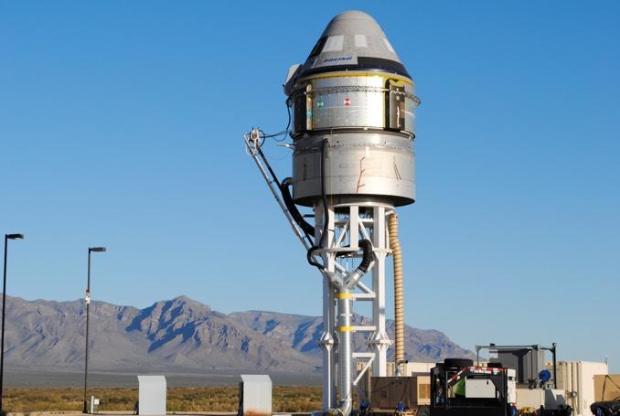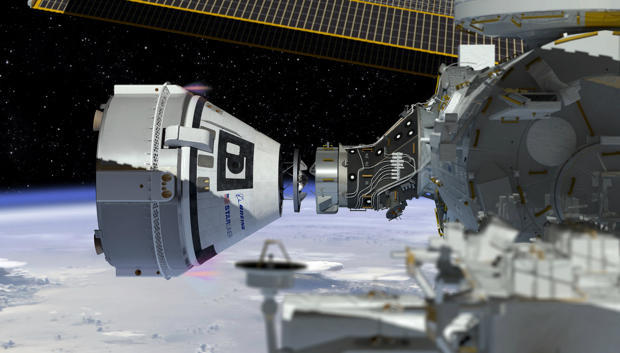Boeing readies Starliner capsule for
critical launch abort test
Simulating a catastrophic failure, Boeing is gearing up to fire an unpiloted Starliner crew capsule's abort engines Monday morning, triggering a high-speed boost from ground level to a height of more than 4,000 feet to prove the spacecraft can safely propel a crew to safety in the event of a low-altitude emergency.
Mounted atop a short support platform at the White Sands Missile Range in New Mexico, the Starliner's four powerful launch abort engines, along with 20 smaller maneuvering jets, are scheduled to ignite at 9 a.m. ET, accelerating the capsule from 0 to 650 mph - straight up - in just five seconds.
The big abort engines were expected to shut down at the end of those five seconds, followed by the maneuvering thrusters about five seconds after that.

A Boeing CST-100 Starliner capsule on a test stand at the White Sands Missile Range for a critical test of the spacecraft's launch abort system.
The capsule then was expected to arc over at the high point of its trajectory - 4,426 feet above the launch site - 19 seconds after liftoff. After jettisoning its forward heat shield, drogue parachutes were to deploy, followed by the spacecraft's three main parachutes about 26 seconds into the flight.
Unlike the Apollo lunar capsules that ended their flights with ocean splashdowns, the Starliner is designed to land at ground facilities in the western U.S., jettisoning its heat shield and inflating airbags to cushion impact while descending under the main parachutes.
For Monday's test, touchdown more than a mile north of the White Sands launch site was expected a minute and a half after liftoff. A Boeing animation shows details of the abort test:
Simulating a catastrophic failure, Boeing is gearing up to fire an unpiloted Starliner crew capsule's abort engines Monday morning, triggering a high-speed boost from ground level to a height of more than 4,000 feet to prove the spacecraft can safely propel a crew to safety in the event of a low-altitude emergency.
Mounted atop a short support platform at the White Sands Missile Range in New Mexico, the Starliner's four powerful launch abort engines, along with 20 smaller maneuvering jets, are scheduled to ignite at 9 a.m. ET, accelerating the capsule from 0 to 650 mph - straight up - in just five seconds.
The big abort engines were expected to shut down at the end of those five seconds, followed by the maneuvering thrusters about five seconds after that.

A Boeing CST-100 Starliner capsule on a test stand at the White Sands Missile Range for a critical test of the spacecraft's launch abort system.
The capsule then was expected to arc over at the high point of its trajectory - 4,426 feet above the launch site - 19 seconds after liftoff. After jettisoning its forward heat shield, drogue parachutes were to deploy, followed by the spacecraft's three main parachutes about 26 seconds into the flight.
Unlike the Apollo lunar capsules that ended their flights with ocean splashdowns, the Starliner is designed to land at ground facilities in the western U.S., jettisoning its heat shield and inflating airbags to cushion impact while descending under the main parachutes.
For Monday's test, touchdown more than a mile north of the White Sands launch site was expected a minute and a half after liftoff. A Boeing animation shows details of the abort test:
Boeing has encountered a variety of technical hurdles and setbacks during Starliner development, putting the program well behind schedule. But the long-awaited pad abort test marks a key milestone in the company's drive to finally ready the CST-100 Starliner for an unpiloted flight to the International Space Station (ISS) in late December.
If that test goes well, Boeing and NASA will set their sights on a piloted test early next year that will carry three crew members to the space station for a six-month stay.
SpaceX also is building an astronaut ferry ship, known as the Crew Dragon, that also is in the final stages of preparation for piloted flights to the space station. Unlike the Starliner, the Crew Dragon is designed to end its missions with ocean splashdowns.
The Crew Dragon already has completed a low-altitude pad abort test and an uncrewed flight to the station. An in-flight abort test is planned for early December, setting the stage for a piloted flight to ISS sometime next year.
Both companies face multiple technical hurdles and reviews before operational crew rotation flights can begin, and it's not yet known which spacecraft will launch a crew into orbit first.
However it plays out, NASA managers are hopeful 2020 will mark the end of a nine-year hiatus in U.S. human spaceflight that began when the space shuttle's retirement in 2011.
Boeing holds NASA contracts valued at $4.2 billion to build and launch the Starliner while SpaceX was awarded $2.6 billion for Crew Dragon development. The goal is to end the agency's sole reliance on Russian Soyuz spacecraft to ferry astronauts to and from the space station.
Both commercial crew ships are designed to enable safe aborts at any point from the launch pad to orbit, and both NASA contracts require the companies to complete on-the-pad and in-flight abort tests before proceeding with piloted flights.

An artist's impression of a Boeing CST-100 Starliner crew capsule docking at the International Space Station.
Monday's test was intended to demonstrate the Starliner abort system will work as required if a crew ever needs to escape from its Atlas 5 booster while still on the launch pad or at extremely low altitudes.
The capsule is equipped with four powerful launch abort engines, or LAEs, each one generating 40,000 pounds of thrust, and 20 orbital maneuvering and attitude control - OMAC - engines providing 1,500 pounds of push each.
The launch abort engines would only be used in an actual low- to mid-altitude abort while the OMAC engines would normally be used to complete the spacecraft's trip to orbit after separation from its Atlas 5 second stage. During a low-altitude abort, the OMAC engines are used to provide additional thrust and attitude control.
The Starliner also is equipped with 28 less-powerful reaction control system engines for use during high-altitude aborts and, in a problem-free flight, to make small changes in the spacecraft's orbit and for docking with the ISS. In Monday's test, only the LAE and OMAC engines were expected to be used.




Ingen kommentarer:
Legg inn en kommentar
Merk: Bare medlemmer av denne bloggen kan legge inn en kommentar.